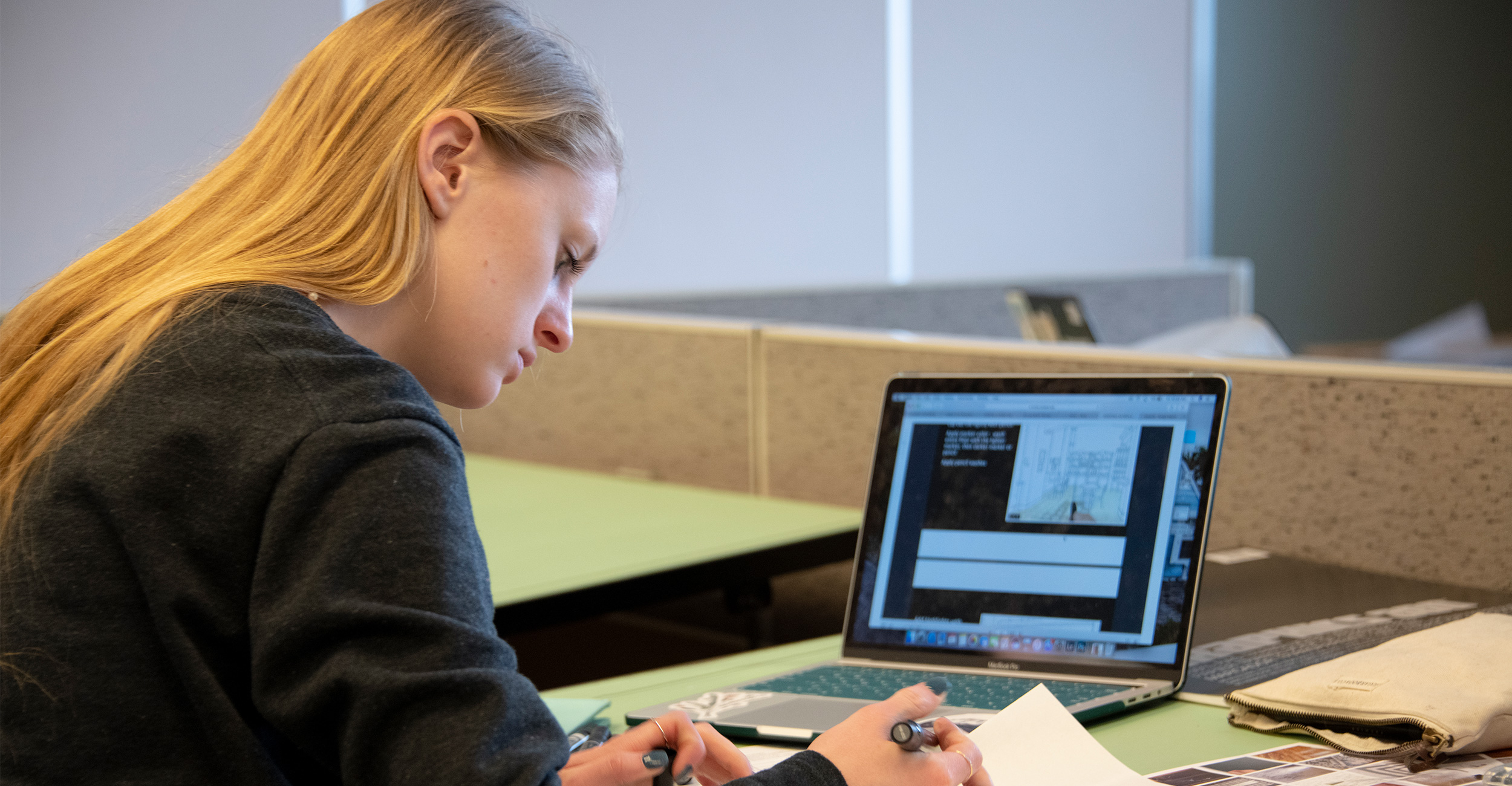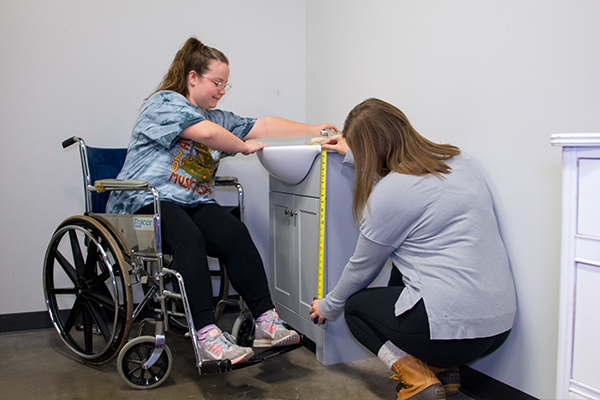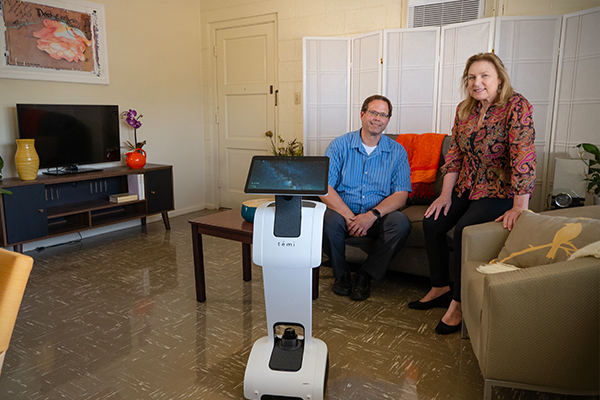
OSU faculty work to bring new ways to address the needs of an aging population
Tuesday, November 28, 2023
Media Contact: Kirsi McDowell | Senior Communications Specialist | 405-744-9347 | kirsi@okstate.edu
We are all aging — from our first breath to our last. Thanks to new medical advances, people are living longer, resulting in an unprecedented growth in the population of older adults.
While this is a win in many regards, an aging population forces our society to rethink the structure of care for those who need extra support.
Dr. Emily Roberts, an Oklahoma State University Design and Merchandising associate professor, has used research and personal experience to develop improvements for an aging community.
“We’re all aging, whether we’re 25 or 75,” Roberts said. “There are things that we can be doing throughout our life to help with that process.”
Roberts has dedicated the past decade of her career to researching the aging process and the physical environment that impacts older adults. While there are many variables, Roberts has worked to find programmatic and design solutions to better serve an aging population.
Changing Perspective
Although Roberts has an architectural background, a personal experience drew her to research the intersection of design and gerontology. She was caring for an older family member and encountered challenges that did not sit well with her.
“The journey I went on caring for my family member opened my eyes to many issues within our health care system which can and should be changed,” Roberts said.
Roberts recalls her family member feeling judged by others who didn’t understand her condition. It was difficult to find proper care and housing accommodations, plus there was a lack of resources.
 The experience prompted Roberts to combine her interior design skills with new insight
to make a change.
The experience prompted Roberts to combine her interior design skills with new insight
to make a change.
She returned to school and completed a Master of Science in gerontology and a Ph.D. in environment and behavior in architectural studies. In 2015, she accepted a job at OSU as an environmental gerontologist.
“I look at spaces where older adults will be, whether it’s at home, a long-term care facility or a memory care facility,” Roberts said. “It gives me a broad lens to look at the aging process, which keeps me very excited about my job.”
One of her first projects was co-developing Active Aging for L.I.F.E. — a program focused on four core areas: longevity, independence, fitness and engagement. OSU brought this curriculum to older adults, college-aged students and the public to educate all demographics about aging practices that promote long-term health.
Additionally, Roberts infuses this curriculum in courses she teaches, challenging students to look at the aging process differently.
“I hope by the end of my classes, students will start thinking about their role in the aging process,” Roberts said. “It’s not us and them; it is we; we are all aging. We must start thinking about what we can do to make things better for an aging population.”
Students are asked to tackle this ethical question by designing spaces that offer accommodations intended to meet potential needs of older adults, such as a dementia village.
A Different Approach
When diagnosed with dementia, individuals often require care from trained professionals and are sent to a memory care setting.
Roberts said that while patients receive the care they need, they often lose a certain level of freedom.
“Here at OSU, we are rethinking the way we care for these vulnerable populations that deserve the same level of autonomy as we do,” Roberts said,
“Just because an individual is living with dementia doesn’t mean they shouldn’t have the freedom to make choices in how to spend their days.”
To create a different model that prioritizes autonomy and focuses on the individual, Roberts looked at care facilities outside the U.S. In her search, Roberts discovered a dementia village.
First created in the Netherlands, a dementia village is a four to 10-acre secured site with indoor and outdoor connection. Trained caretakers and nurses assist residents with day-to-day activities, but residents are free to make personal decisions on how they want to spend their days within the village. They include housing, grocery stores, gardens and other venues residents are free to explore and use.
While European countries found success in this model of care, the U.S. has yet to adopt these practices due to existing paradigms of care. Nonetheless, Roberts remains determined in her pursuit to bring the village alternative to the U.S.
Thinking Outside the Box
Following a visit to the dementia village in the Netherlands, Roberts experienced a “lightbulb” moment while visiting an existing mall.
“The malls in America have similar design aspects to the dementia villages including open walking areas and opportunities for inside and outside transitions,” Roberts said. “Many malls are closing in the U.S. due to online shopping and other factors. Repurposing the infrastructure of these spaces for the village model makes sense on many levels.”
Students have helped Roberts bring this new idea to life by designing an 800,000-square foot case study of a dementia village within the walls of a closed mall. Roberts traveled to Washington, D.C., to share this idea with lawmakers and has been interviewed by “The New York Times” and National Public Radio on the conceptual model.
Her hope is to bring attention to the possibilities of thinking outside the box at the federal and local levels.
 In addition to her work on new models of care, Roberts recently co-edited a book on
the future of long-term care and is working on assistive technology and robotics for dementia home care. She and Dr. Alex Bishop,
OSU Human Development and Family Science professor, are currently working on testing
for remote caregiving technology with a newly purchased TEMI robot in her Human Environmental
Factors Lab.
In addition to her work on new models of care, Roberts recently co-edited a book on
the future of long-term care and is working on assistive technology and robotics for dementia home care. She and Dr. Alex Bishop,
OSU Human Development and Family Science professor, are currently working on testing
for remote caregiving technology with a newly purchased TEMI robot in her Human Environmental
Factors Lab.
Looking ahead, Roberts continues to work on her projects while educating students and the public about aging.
“Aging is part of the human experience,” Roberts said. “We are all on that journey because we are all aging throughout our lifespan — whether you are college-aged, middle- aged or an older adult. As designers and human scientists, it is our ethical role to work toward new paradigms of understanding for an aging population, both now and in the future.”
Photos By: Kelly Kerr and Diana Haslett
Story By: Sierra Walter | ASPIRE magazine
